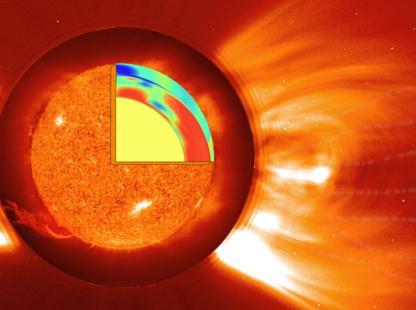
Awards
Professor Kosovichev (PI) and CCH Team Earthcube Project - Intelligent Databases and Analysis Tools for Geospace Data
To facilitate interdisciplinary research on solar influences, this project will develop a unique data environment that will integrate new and archived satellite and ground-based observational data. The integrated data environment will allow researchers to efficiently access solar and geospace data and use them for studying fundamental problems of solar activity and variability and their impacts on Earth systems, as well as for developing new predictive capabilities.
The innovative interdisciplinary approach for building an intelligent integrated database, developed in collaboration between heliophysicists and computer scientists, will contribute to knowledge discovery in the EarthCube and associated fields.
The EarthCube Project page.
NASA Press Release: Realistic Simulations Reveal Something New Under the Sun
Using a 3D global magnetohydrodynamics code called EULAG-MHD, Andrey Stejko, a Ph.D. candidate at New Jersey Institute of Technology (NJIT), and his advisor Alexander Kosovichev, director at the Center for Computational Heliophysics at NJIT, in collaboration with Gustavo Guerrero, Universidade Federal de Minas Gerais, Brazil, found that the tachocline—the transition area between the radiative and convective layers of the Sun, located about 120,000 miles beneath the solar surface—plays a much larger role in the evolution of the magnetic field than scientists previously thought.
"We found that the magnetic field generated by the solar dynamo is amplified and stored in the tachocline," said Kosovichev. "This explains something we have been seeking to understand: why the duration of the full magnetic cycles is 22 years, and not shorter. These magnetic cycles result in 11-year cycles of sunspots and flare activity."
The importance of the tachocline for the solar cycles was suggested by astrophysicist Eugene Parker soon after its discovery in 1992. "Our simulations have provided the first convincing evidence for this elusive phenomenon, and opened new opportunities for deeper understanding of the mechanism of the solar cycle that has fascinated scientists for more than four centuries," said Kosovichev.
"Looking at these cool visualizations sometimes feels like looking directly inside of a star, which is something that’s never been possible before," Stejko said.
Read the Full Press Release.
Professor Oria Wins 2015 Test of Time Award
Computer science professor Vincent Oria has won the prestigious Test of Time Award given by the Association for Computing Machinery’s Special Interest Group on Management of Data (SIGMOD) in recognition of his paper, “Robust and Fast Similarity Search for Moving Object Trajectories.”
Oria co-authored the write-up, which has been cited nearly 700 times since it was published in 2005, with Lei Chen, an associate professor in the department of computer science and engineering at Hong Kong University of Science and Technology and M. Tamer Özsu, a professor of computer science at the University of Waterloo.
The paper introduces a novel distance function called Edit Distance on Real sequence (EDR), which is robust against potential data imperfections when working with existing distance functions and moving object trajectories. The paper also presents three pruning techniques to improve the retrieval efficiency of EDR.
Oria’s paper has spurred follow-up work on trajectory clustering to capture the basic relationship of moving objects in similar trajectories in applicable scenarios such as tracking animals in the same herd according to their migratory trajectories; analyzing the shopping habits of users in a shopping mall from their moving trajectories; and mining human relationships (i.e., husband/wife, colleagues, friends) based on their daily trajectories.
The Test of Time Award recognizes the best paper from the SIGMOD proceedings 10 years prior, based on the criterion of identifying the paper that has had the most impact (research, products, methodology) over the intervening decade and is chosen by the SIGMOD Awards Committee.
“This paper has opened some doors,” says Oria, who recently attended the 2015 SIGMOD conference in Melbourne, Australia to accept the award. “The previous recipients are all famous in their field and come from prestigious universities. This is recognition that we do some quality work here at NJIT.”
Professor Kosovichev Wins 2015 NASA - Group Achievement Award
"Heliophysics Modeling and Simulation Team"
Professor Alexander Kosovichev has won the 2015 NASA - Group Achievement Award "Heliophysics Modeling and Simulation Team" for significantly enhancing communication and collaboration across the heliophysics research community through technical and outreach excellence.
The Heliophysics Modeling and Simulation (HMS) Team, which includes heliophysics researchers as well as event and media experts, completed an ambitious agenda in 2014. Their exceptional efforts have rapidly established NASA as a community-builder in heliophysics research, and have significantly advanced the goal of NASA’s Living With a Star (LWS) Program to predict the Sun’s behavior and its influence on the Earth.
Heliophysics and space weather include a broad set of physical and research domains, including the solar interior, photosphere, chromosphere, heliosphere, and interactions of the solar wind with Earth’s magnetosphere, thermosphere, and ionosphere. These domains each have their own specialized physics and modeling approaches, domain experts, and technical meetings within the research community. Unfortunately, integration across and communication within this diverse community has been incomplete, resulting in slowed advancement toward the LWS goal. The HMS team undertook the challenge of integrating the community more tightly together and, in so doing, has accelerated advancement in heliophysics research.
Through the HMS team’s vision, dedication, and expertise in planning and hosting heliophysics research community-building events, heliophysics researchers worldwide are collaborating more robustly and, as a result, are more quickly advancing toward NASA’s goal to predict the Sun’s behavior and its influence on the Earth.
Team Members:
NASA Ames Research Center: David Hathaway, Nagi N. Mansour, Gina Morello, Alan Wray
Computer Sciences Corporation: Daniele Beyk, Nick Bonifas, Chris Buchanan, Chris DeSilva, Jill Dunbar, John Hardman, Sue Kim, Katie Massaro, Michelle Moyer, Chris Tanner
Oak Ridge Associated Universities: Irina Kitiashvili
New Jersey Institute of Technology: Alexander Kosovichev
Taksha University: Ravi Deepak